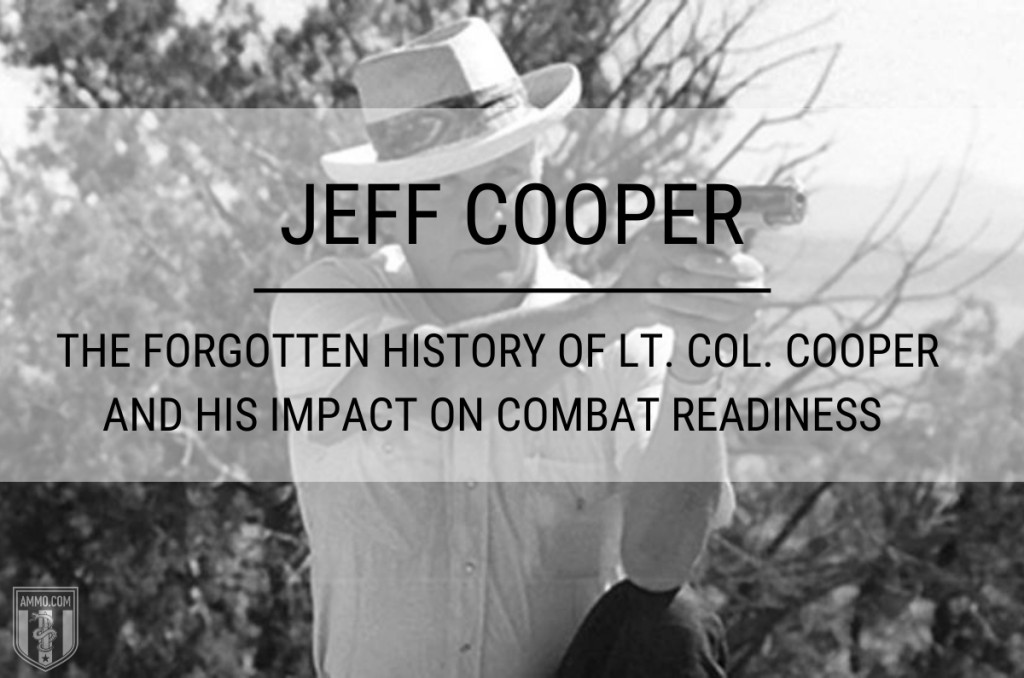by Sam Jacobs, Ammo.com, CC by 4.0 International

(Oct. 20, 2021) — The United States Marines have a saying: “Every Marine a rifleman.” That being said, some of them are pretty handy with a pistol, too.
Lt. Col. Jeff Cooper literally wrote the book on modern handguns in combat. In fact, you’re probably already acquainted with a number of concepts he introduced to the world of pistols, even though you might not know his name. Some of them are so common sense and simple that it’s hard to believe anyone had to invent them.
This was the genius of Jeff Cooper.
Jeff Cooper’s Marine Corps Career
It’s impossible to tell the story of Jeff Cooper without talking about the United States Marine Corps. Indeed, Cooper enrolled in the Junior ROTC program when he was still studying at Los Angeles High School. He then attended Stanford, earning a degree in political science before receiving his commission in the United States Marine Corps.
During World War II he served in the Pacific Theater, earning the rank of major. In 1949, he resigned his commission, but duty called during the Korean War and so, Cooper returned. He served in irregular warfare and earned a promotion to Lieutenant Colonel. After the war, he applied to remain on active duty but was rejected.
From there, Cooper earned a master’s degree in history and taught part-time at a high school and a community college. Here he remained until the early 1970s when he applied his passion for teaching to his passion for weapons.
It was in 1976 that Cooper founded the American Pistol Institute, now known as the Gunsite Academy. While he primarily taught rifles and shotguns to law enforcement, the concepts developed by Cooper during his time running the American Pistol Institute for pistols and long arms alike are used by every intelligent and responsible gun owner to this day.
Jeff Cooper’s Combat Readiness
It was at the American Pistol Institute that Cooper developed the modern technique of the pistol. This was his system for pistol combat. Without knowing what it’s called or who invented it, much of it will seem familiar to you:
- Large caliber, semi-automatic pistol: Cooper was an early advocate of the 1911 and a big caliber to go in it. At a time when most men favored wheel guns, Cooper believed there was simply no substitute for a semi-automatic with a big round like a .45 ACP.
- The Weaver stance: Opinions vary on the best stance for combat, but Cooper was a strong supporter of the Weaver stance, developed by Los Angeles County Deputy Sheriff Jack Weaver through his experiences in competitive shooting.
- The draw stroke: Cooper preached the importance of the draw stroke. A holstered weapon doesn’t do anyone any good. So Cooper drilled his students to consistently practice drawing their weapon with perfect form to be combat-ready.
- The flash sight picture: Just as a holstered weapon is useless until drawn, so too is a weapon useless if not pointed in the right direction. The flash sight picture is a method of quickly targeting an attacker with sufficient accuracy. It is essential in life-or-death situations.
- The compressed surprise trigger break: Considered the “secret” of quick and accurate shooting, the compressed surprise trigger break, which is a somewhat more sophisticated version of the “double tap.” While Cooper did not invent the double tap, he systematized the training for such.
All of the above are basic combat training for civilians, military, and law enforcement alike. While Cooper didn’t “invent” any of it, per se, he synthesized previously existing methods into a cohesive program of combat readiness just about anyone could learn.
Cooper also developed a system for evaluating combat readiness called the firearms conditions of readiness:
- Condition 4 is when the chamber is empty, there is no magazine in the gun, the hammer is down, and the safety is on.
- Condition 3 is after a full magazine has been loaded.
- Condition 2 is after a round is chambered.
- Condition 1 is after the hammer is cocked.
- Condition 0 is when the safety is released.
Condition 0 is when the weapon is fully ready to fire, requiring only an operator to pull the trigger. Condition 1 would not apply to hammerless semi-automatics, but as Cooper was a 1911 aficionado, he included a step for cocking the hammer.
In addition to the condition of the weapon, Cooper also formulated a system for appraising one’s personal readiness for combat, using a color-coded system:
- White represents a total lack of situational awareness. You are completely surprised by your attacker and relying upon his ineptitude to save you.
- Yellow is simply a vague awareness that the world is a sometimes dangerous place where you might have to defend yourself using deadly force. You are appraising situations for danger all around you. Cooper described this as “I might have to shoot.”
- Orange is when you have identified a specific danger. Maybe something just doesn’t look right. Orange elevates your awareness from “I might have to shoot” to “I might have to shoot him.” It is a more targeted version of yellow’s watchful waiting.
- Red is combat. You have identified a deadly threat to yourself or your loved ones and are about to begin shooting.
The United States Marine Corps used this system but added a code black which means that combat is in progress or you are too paralyzed by fear to act. Cooper never used this level in his system.
This threat level assessment system is an elegant way to check to see how we are appraising situations in potential combat. For those who carry on a regular basis, it is absolutely essential to evaluate the threat level at all times and to train oneself for situational awareness. Cooper later simplified his explanations of the color codes, but the basic framework remained in place.
Read the rest here.

